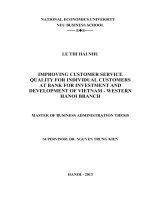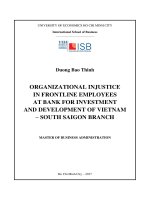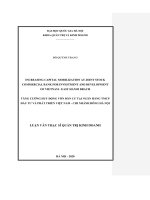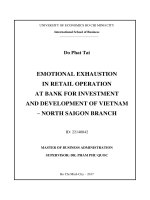improving customer service quality for individual customers at bank for investment and development of vietnam - western hanoi branch
Bạn đang xem bản rút gọn của tài liệu. Xem và tải ngay bản đầy đủ của tài liệu tại đây (475.79 KB, 95 trang )
NATIONAL ECONOMICS UNIVERSITY
NEU BUSINESS SCHOOL
LE THI HAI NHU
IMPROVING CUSTOMER SERVICE QUALITY
FOR INDIVIDUAL CUSTOMERS AT BANK
FOR INVESTMENT AND DEVELOPMENT OF
VIETNAM - WESTERN HANOI BRANCH
MASTER OF BUSINESS ADMINISTRATION THESIS
SUPERVISOR: DR. NGUYEN TRUNG KIEN
HANOI - 2013
2
ACKNOWLEDGEMENT
During EMBA course, I have collected a lot of knowledge about business
administration. First of all, I would like to thank all professor lecturers whose
experience helped me a lot in developing the thesis.
I also express my great gratitude to my supervisor, Dr. Nguyen Trung Kien
from National Economics University whose encouragement, guidance from the
initial to the final level enabled me to develop an understanding of the subject.
Special thanks to my fellows of EMBA9A who always support me in many
ways during my time of studying the course and doing this thesis.
I would like to thank my husband, whose love, patience and persistent
encouragement to me have helped me to overcome difficulties in this study.
Last but not least, words to me to thank everybody who supported to the
successful realization of thesis with valuable information, as well as expressing my
apology that I could not mention personally one by one.
The thesis could not be done without all of those supports.
2
3
TABLE OF CONTENTS
3
4
ABBREVIATION
BIDV Bank for Investment and Development of Vietnam
CRM Customer Relationship Management
WTO World Trade Organization
ATM Automated Teller Machine
POS Point of Sale
SMS Short Message Services
EVN Vietnam Electricity
4
5
LIST OF FIGURES
5
6
LIST OF TABLES
6
7
LIST OF DIAGRAMS
7
8
EXECUTIVE SUMMARY
Currently, up to the global trend, commercial banks in the country
understand that developing retail banking services for individual customers has now
been a new and stable trend of development in the difficult economic situation.
Aware of risks during the economic downturn, commercial banks in recent years
redirected to promote business banking services to individual customers . Individual
customers have become one of the important factors determining the survival and
development of banks. In an environment full of fierce competition, maintaining
good relations with old customers, retain loyal customers is not easy. In this context,
what are the most important in the absence of product differentiation, product
quality, the price, the product supplying process? The first thing we should think of
is the quality of banking services. “How to make them choose us and trust us to
introduce new customers” is a more difficult question for Bank for Investment and
development of Vietnam – Western Hanoi branch. One of the most realizable
methods to help Western Hanoi branch is to improve the individual customer
service quality.
In this economic background, BIDV Western Hanoi branch also has to face
so many challenges to compete with the other banks with good customer service.
With the aim of this thesis of assessing the current individual customer service
quality in BIDV Western Hanoi branch, the objectives of this research are
formulated as follows:
- Analysis of the current situation of customer service quality at BIDV -
Western Hanoi branch: What are the strengths and weaknesses?
- Identify the causes to the weakness of individual customer service quality
at BIDV - Western Hanoi branch.
- Propose solutions to improve the individual customer service quality at
BIDV - Western Hanoi branch.
8
9
This thesis has used secondary data gathered form BIDV headquarters,
BIDV Western Hanoi branch as reports, banking magazines in internal system,
internet websites, newspapers and primary data collected by depth interview with
the head of customer transaction department who have experience and deal daily
workload with individual customers; and surveys of 100 customers who have been
using banking services at BIDV Western Hanoi branch.
According to above methodology, the research has analyzed 5 dimensions of
SERVQUAL model – the most common method for assessing and measuring
service quality: Reliability; Assurance; Tangibles; Empathy and Responsiveness.
There are some shortcomings were given out:
- Incompletely customer information
- Unqualified and shortage of the staff
- Unprofessional “soft” skill of the staff
- Unreasonable transaction procedure
- Poor customer management
- Error information technology.
Base on the above shortcomings on individual customer service quality of
BIDV Western Hanoi branch, some recommendations have been mentioned to
improve the individual customer service quality of the branch in the coming years:
- Building customer information system
- Improving the quality of staff at the branch
- Improving communication skills of banking teller in direct contact with
customers.
- One-door transaction procedure innovation at the branch
- Applying the model of customer relationship management CRM to
improve customer service quality.
- Application of modern banking technology.
9
10
INTRODUCTION
1. Rationale
In the context of difficulties in Vietnam's economy having significantly
influenced on the survival and development of enterprises, many business bank
loans falling into the risks of being difficult payment or bad debts for all
commercial banks. Therefore, individual customers become an extremely potential
market segment. However, the competition in this segment is not a small challenge
for any bank to participate. Increasing people's knowledge, the customers’ deeper
understanding of banking products, the boom numbers of banks invisibly increase
customer empowerment. Customers have the right to review and choose the best
products and service. Why commercial banks are willing to invest in individual
customer market segment?
First, enterprises have faced so many difficulties in order to approach capital
from banks due to their financial situation does not have the ability to create trust in
banks. Second, the individual customer markets are abundant especially during the
economic downturn. People are always in need of safe investment, they do not want
to participate in high profit sector investment but accompanied by the risk of
bankruptcy. If there is a good business strategy for this object, the bank will attract
and catch a huge number of customers. This could be considered as the biggest
objective of each bank on the market.
The competitiveness level in bank sector now is higher and higher. Bank
products cannot create competitive advantage, bank interest and service fee cannot
always lower in order to attract customer. Customers, especially individual
customers are more and more fastidious. In this economic background, BIDV
Western Hanoi branch also has to face so many challenges to compete with the
other banks with good customer service. “How to make customers feel happy when
10
11
using bank services and return” is a big question of BIDV. One of the most
realizable methods to help BIDV is to improve customer service quality.
Good service is indeed the lifeblood of any business. We can offer
promotions and slash prices to bring in as many new customers as we want, but
unless we can get some of those customers to come back, our business won’t be
profitable for long.
Figure 1. Factors that impact customer choice of provider
Source: Industry Survey and Research for long distance provider(2006)
According to a survey of the factors affecting the customer choice from the
paper “Industry Survey and Research for long distance provider”, year 2006, it has
shown that the most important factor affect to customer’s decision of choosing a
company product of service is "Customer service" (34%) while company’s brand
name, image is 21%, "Cost / Value (15%), "Billings (14%), “Other factors”
accounted for 16%. Banking is a special business services sector - financial
solutions for all different demands, products are more easily imitated, the product
difference is negligible the "Customer Service" plays an important role for banks
to create competitive advantage as well as building the image / brand.
With the above analysis, the authors choose the topic "Improving customer
service quality for individual customers at Bank for Investment and Development of
Vietnam - Western Hanoi Branch" for this thesis.
2. Research objectives
In order to propose a solution of "Improving customer service quality for
individual customers at Bank for Investment and Development of Vietnam -
Western Hanoi Branch ", the thesis focuses on the following objectives:
- Analysis of the current situation of service quality from customers’
assessment at BIDV - Western Hanoi branch: What are the strengths and
weaknesses?
11
12
- Identify the causes to the weakness of individual customer service quality
at BIDV - Western Hanoi branch.
- Propose solutions to improve the individual customer service quality at
BIDV - Western Hanoi branch.
3. Research questions
- How to measure the individual customer service quality at BIDV - Western
Hanoi branch?
- What are the weaknesses of individual customer service at BIDV - Western
Hanoi branch?
- What are the causes of these weaknesses?
- How to improve individual customer service quality at BIDV - Western
Hanoi branch?
12
13
a. Research methodology
4.1. Research process
Indepth interview
Determining the evaluation model
Collecting information/data
Analyzing data
Secondary information
Survey
Proposing Solutions
Determining the causes
Diagram 1. The process of conducting research
Research process is carried out through by 4 steps: Determining the evaluation
model; Collecting information / data; Analyzing data; Determining the causes and
Propose solutions to improve the individual customer service quality at BIDV -
Western Hanoi branch. SERVQUAL model is used as the theoretical model.
4.2. Data collection
Information and data used to assess the quality of individual customer
service at BIDV - Western Hanoi branch collected by the 02 sources:
- A secondary source of information: The information collected by the author
through the newspaper, analysis, internet related to customer service quality of BIDV.
- Primary information: That is information collected from the evaluation of
the quality of customer service of BIDV - Western Hanoi branch on the point of
customer’s view based on specific criteria. This information source help BIDV -
Western Hanoi branch realize their weaknesses and strengths. The author chose 2
formally gathering information: in-depth interview and questionnaire survey.
* Implementation of the survey:
- Design survey questions: The survey questions are designed according to
05 criteria for assessing the quality of customer service quality SERVQUAL for
measuring individual customer service at BIDV - Western Hanoi branch. To get a
13
14
detailed assessment, each criterion is divided into small criteria, this action makes
customers feel easier to answer as well.
- Methodology: Survey Forms are sent to the customer has been using the
services of the Bank via email (the author uses simple list of major customers who
have direct interaction)
- The number of the survey: The survey sent to 300 customers but due to
some unexpected reasons, authors only get 104, but only 100 early feedback is used
to analyze
- Implementation survey: The survey was carried out in the period of 07 days
from 31/09/2012 to 06/10/2012.
* In-depth interview:
After survey by questionnaire, the author interview the leader of business
unit- specifically the departments processing works relating to individual customers
such as Individual Customers Transactions department or Individual Customers
Relations department. Through these interviews, the author may understand the
viewpoint of the interviewee about the current situation of individual customer
service, the opinion about the quality of individual customer service in commercial
banks in general and in BIDV Western Hanoi branch in specifically, and how to
improve this quality in BIDV Western Hanoi branch to enhance the competitiveness
in this difficult stage.
The interviewee: Ms. Nguyen Thi Hoa – Head of Customers Transactions
Department of BIDV Western Hanoi branch.
4.3. Data analysis
All information and data are collected by using analysis tools in the
assessment model to assess study subjects through the information gathered from
the survey.
• First of all, secondary data will be collected, doing statistic, compare…
• To obtain exact result, I use Excel software to process primary data.
b. Research scope
14
15
- Content: The actual situation of service quality from individual customer’s
point of view at BIDV Western Hanoi branch from all transactions and
headquarters.
- Timeframe: Data was collected during the period from the year 2009 to
2012, in which the secondary data was collected from 2009 to the first half of 2012
and primary data was carried out from 30/09/2012 to 31/10/2012.
c. Thesis structure
Apart from the content, the main parts of this thesis are divided into three chapters:
Chapter 1. Theoretical background for customer service quality.
In this chapter, the author discusses the theoretical background for customer
service quality in commercial banking as well as goes deeper to learn about
Customer service quality measurement model - SERVQUAL and the aspects of
customer service quality.
Chapter 2. The current situation of individual customer service at BIDV
Western Hanoi branch.
Based on the information / data from customer comments, banks, and other
information / data on other media, author analyzes the individual customer service
quality at BIDV Western Hanoi branch, find out the strengths, weaknesses and causes.
Chapter 3. Solutions to improve the individual customer service at BIDV
Western Hanoi branch.
Based on the actual situation analysis study of subjects given in Chapter 2 and the
context of the banking market in Vietnam, the last chapter proposes
recommendations to improve the individual customer service at BIDV Western
Hanoi branch. The conditions for the implementation of these proposals are
discussed in the last section of this thesis.
15
16
CHAPTER 1. THEORETICAL BACKGROUND
OF CUSTOMER SERVICE QUALITY
1. 1. The concept of service quality in commercial banks.
1.1.1. The concept of customer service.
* Definition of customer service:
Service is an activity that its products are intangible. It solves the relationship
with the client or customer-owned assets without transferring ownership.
According to Looy et al (2003, page 11), "service is any activity that one
party can offer another that is essentially intangible and does not result in the
ownership of anything".
According to ISO 8402: The service is the result generated by the action
between the supplier and the customer and the supplier's internal operations to meet
customer needs.
* Characteristics of customer service
- Intangibility (or non-material):
One cannot see, taste, hear, cannot stop the service before consumption.
Invisibility is the main characteristics to distinguish banking products with the
products of other manufacturing material. Banking products usually follow a
process rather than specific objects can be observed held. Thus, the bank's
customers often have difficulty in assessing the quality of customer service to make
the decision to choose and use products and services.
- Simultaneity:
The process of service production and consumption occur at the same time.
Services cannot be separated from its source, while existing material goods does not
depend on the presence or absence of its origin.
By the supplier and the consumer banking products and services occur at the
same time, especially with the customer directly involvement in the course of
16
17
providing products and services. Results services are affected by the relationship
between customer and suppliers of products and services. This feature requires a
close coordination between the customer and the Bank in providing accurate two-
dimensional information. Banks usually create, maintain and develop customer
relations by improving the quality of the supply of products and services,
development of customer care in the entire staff of the Bank and supply system
modernization.
- Heterogeneity:
Service quality varies in a very wide range, depending on the circumstances
created services (such as suppliers, time and place of supply, etc.). In banking
operations, customer service quality depends very much on the products and
services offered, transaction time, the desired needs of customers, the level of
expertise, attitude of staff, All these elements are unstable.
- Perishability:
Due to the characteristics of services that cannot be divided, it cannot be
stored. This feature will not cause great impact on quality of service when demand
is stable and there are no big changes. Many companies which provide services
usually apply the best measures to regulate supply and demand over time: the
implementation of measures to increase the existing capacity to serve customers
during peak hours can be mobilized to increase staff from other departments,
* The role of customer service
"No customer, no company survive." Review of the famous economist
Erwin Frand has shown the role of customers in all business fields. In the downturn
period of economy, the company was faced significant decrease of revenue, leading
to staff cuts and downsizing service scale. But it does not help the company regain
growth momentum. In the difficult times, the service must be the top priority
business interest. Failing in price competition, companies tend to choose service as
the last option in order to create competitive advantage. If an organization with
17
18
whether goods or services provided in a qualifying period on the market do not have
good customer service support, the customer will gradually leave that company.
1.1.2. The concept of customer service quality
Services quality is what customers perceive. Service quality is determined
based on the customer's perception or feeling related to their individual needs.
According Parasuramal, Zeithaml and Berry (1985), the quality of service as
perceived by the customer on a service level has created value for their previous
expectations. Also according to Parasuramal, the expectation in service quality is
what customers want, this means they feel that the provider have to implement, not
perform the requested services.
According to Hurbert (1995), before using the service, customers have had
an expectation about that service. When customer expectations and service quality
of suppliers are not the same, customers will feel dissatisfied.
According to ISO 8402, service quality can be considered as "the entire of
characteristics of an object, giving that object the ability to satisfy the requirements
stated or implied." It can also be understood that service quality is customers’
satisfaction measured by the difference between the expected quality and the
achieved quality.
Expectations of customers (what customers want) made up of four sources:
- Oral Communication;
- Personal needs;
- Undergone experience;
- Advertising and promotion
In these four sources, only the fourth is located in the control of the
company.
Ensuring and improving the quality of service actually are to reduce and eliminate
of the distance:
18
19
- Between service expectations and management's perception of customer
expectations;
- Between management perceptions of customer expectations and the action
of making the perception become service quality parameters;
- Between turning awareness into the quality of service parameters and
service provision;
- Between service providers and external information to customers;
- Between service expectations and service benefit
Therefore, the quality of service related to customer expectations and their
perceptions of the service. Building a system of customer expectations is essential
to improve the quality of customer service in each kind of business. Customer
service mission is informed to all employees of the bank and given authority,
responsibility, specific to each department staff, especially staff dealing directly
with customers. The bank has a mechanism for attaching the rights and
responsibilities of staff in dealing with customers, especially for effectively bring in
to play the policy to encourage adequate for employees with good service attitude
and attract more customers to the bank.
Strengthening infrastructure, modernizing technology to improve customer
service quality and serve customer timely, accurately and quick. This may also raise
the reputation, image, symbol of the bank.
Focusing on arranging appropriate dealing time with their client and working
outside office hours and holidays are a common activity of many banks now.
1.1.3. The factors affecting the customer service quality
* Internal factors
This is the group of intrinsic factor itself each bank, these factors are often
decisive nature of the process of the bank's activities.
+ The financial potential, organizational structure and the bank's reputation
19
20
Any business that wants to do business on the market must have a certain
financial capacity. For operation the bank financial strength is an important factor in
the development of new services, improving traditional services increase the
competitiveness of the market.
Organizational structure of the bank is an important factor, a bank
organizational structure of the logical structure of the suite, customers can have
access to these services at your convenience. The individual customer needs always
diverse, rich, related to customer activities.
+ The conception of development of banking services to individual
customers of commercial banks. Strategy is the plan of action outlined in order to
achieve some specific goal. Strategic orientation and development platform built on
the basis of the survey, survey customers, the economic environment, competition,
banking resources. Base on those to make the development plan in a certain period
of time for the service that is supplied in the market.
+ Informational technology application
In banking activities, the application of information technology is an
important factor, a direct impact on service quality as well as quantity and quality of
customer care that banks can supply out of the market. Today, the tendency to use
services through electronic channels without having to go to the bank every day,
save time and travel costs of the customer.
+The communication skills of staffs
In all social and economic activities, people have a very important role. In
the banking sector, too, man is a decisive factor in the development of each bank
itself. Serving attitude of the staff is an important factor leading to the individual
client. So trained staff of professional adapting with openness, politeness and
respect the customer is a significant factor contributing to helping customers look
favorably on the banks and banking services provided.
+ Marketing activities
20
21
For each bank, marketing is indispensable, this activity has a very important
role in the market economy and especially in the current integration trend. This
activity will help to reduce distance between customers and banks together, through
which the banking services provided will be easier to be accepted by customers.
Marketing activities covered by the following:
o Market survey: The purpose of market research is to grasp the market
changes and timely develop those changes in order to capture the customer
needs to provide banking services in the best way.
o Service quality management
Based on these needs, the bank will take into consideration the conduct of
the provision of services to suit each kind of customer and control the development
of this service, this is the work of the service management thereto. For example,
from market research on customer needs to use the card, banks determine the
current and future needs of customers is used to pay for online goods and services,
paying agent, etc. which banks offer credit cards, debit card, Good service
organization management will bring many advantages to the bank because this will
make the services to be brought to right customers and achieve the objectives set for
each service, thereby creating conditions for development services.
o Promote and selling services
This activity aims to introduce the service to the customer, make the
customer know that banking services and supply in the market. As well as other
services promoting services is important, but the banking industry, it is more
important.
The promotion and advertisement will create customer confidence and
introduce banking services to customers.
* External factors
+ The development of the economy and the integration process
21
22
Economic integration is becoming an objective trend of world economic
development as well as the economic development of each country. Manifestation
of this process is to increase the flow of international exchange of trade, capital,
finance, technology and services. This gives the bank a lot of opportunities such as:
market expansion, management experience, scientific and technological inheritance
bank. But besides that, the banks also have to deal with many challenges and risks
arising from the integration process.
+ Legal Environment
These are factors of the external environment have a major impact
consequently to the operation of organizations and individuals in the economy. With
commercial banks, the middle of an important role in the economy, under the strict
control of the new law since the establishment as well as during operation is
inevitable. The law creates a legal basis for the operation of the bank in the form of
the Law, the laws, ordinances, decrees, regulations, etc. These regulations force
banks to comply.
+ The socio-economic environment
Socio-economic environment has a major influence on the activities of the
economic entity. These effects will impact the activities of people and organizations
in the economy. Bank is an economic organization plays an important role in the
economy, so the bank's activities are sensitive to the socio-economic changes. Any
variation also has a certain impact on customer care operations of the bank.
1.2. Customer service quality measurement model
1.2.1. Five - distance service quality model
Parasuraman and CTG (1985, 1988) are the pioneers in service quality
research in the marketing area specifically and detailedly. The researchers made the
model of five gaps model of service quality. Model is shown in diagram 3.1.
The first gap occurs when there is a difference between customer
expectations of service quality and service manager’s perception of customer
22
23
expectations. This difference is due to service companies not fully understanding
what characteristics make up the quality of their services and how to transfer them
to customers to satisfy their needs.
Second gap occurs when the service companies have difficulty in changing
their perception of customer expectations into service quality characteristics. In
many cases, companies can realize the expectations of customers, but the company
does not always convert these expectations into specific criteria for quality and
convert in accordance with customer expectations. The main cause of this problem
is the ability of service staff as well as excessive fluctuations of service. Sometimes,
there are so much demand that the company is not unable to meet.
Third gap occurs when employees do not transfer services to customers
according to the criteria defined. In service, the employees who have direct contact
with customers play a very important role in the process of creating quality.
However, it’s very difficult for all employees to complete the task according to the
criteria set out at any time.
Advertising and information media also impact on customer expectations of
service quality. The promises in promotional advertising programs can increase the
expectations of customers but also will reduce the quality that customers feel when
they do not comply with what was promised. This is the fourth gap.
The fifth gap occurs when there is a difference between the quality expected
by our customers and the quality they feel. Service quality depends on the fifth
distance. If a service meets the customer expectations, it means if the customer finds
no differences between the expected quality and the felt quality while using service,
it’s actually a perfect service.
Parasuraman and CTG (1985) assumed that service quality is a function of
the fifth distance. The fifth gap depends on the distance of 1, 2.3 and 4. So, to
narrow the fifth gap, or improve service quality, service managers must attempt to
shorten this gap.
23
24
Service quality model, according to those researchers, can be performed as
follows:
SQ = F {Gap 5th = f (Gap 1st, Gap 2nd, Gap 3rd, Gap 4th)}
In which, SQ is service quality and Gap 1st, 2nd, 3rd, 4th, 5th are the first,
second, third, fourth, fifth gap.
Expected service
Perceived service
Information to customers
Quality criterion
The perception of company about customer’s expectations
Delivered service
Gap 1st
Gap 2 nd
Gap 3 rd
Gap 4 th
Gap 5 th
Customer
Banker
Diagram 1.1. Service quality model
(Source: Parasuraman, A., Zeithaml, V.A and Berry 1991. Human resource management)
1.2.2. Components of service quality
Service quality model of Parasuraman and CTG (1985) delineates an overall
picture of service quality. According to Parasuraman and CTG (1985), at any
service, service quality perceived by the customers can be modeled into 10
components. They are:
• Reliability: the ability to carry out the service in an appropriate and timely
way in the very first time.
24
25
• Responsiveness: the willingness and readiness of the service staff to supply
services
• Competence: the professional standard of the service staff to perform
services
• Access: relate to facilitate comfortable conditions for customers to access
service such as shorten the waiting time, provide favorable opening time and
place for customers
• Courtesy: express the respective and friendly manner of the service staff.
• Communication: communicate to customers in an understandable way of
expression and know how to listen to their problems such as explain service
fees, settle their complaints and inquiries.
• Credibility: the ability to create trust of the customers in the company,
through the name of the company, the direct communicating way of service.
• Security: the ability to ensure the security for customers such as financial
security as well as customers’ information security.
• Understanding/Knowing the customer: the ability to know well the
customers’ demands by realizing their needs and recognizing their regularity.
• Tangibles: expressed by the appearance, uniforms of the service staff and
available service facilities.
The above ten-component model has the advantage of covering almost every
aspect of service. But its disadvantage is complicated for measurement.
Furthermore, this model is theoretical, there may be many components of service
quality models do not achieve value distinction. This is why these researchers
repeatedly tested this model and came to the conclusion that service quality consists
of five basic components, and banks need to build the basis of assessment through
the level of service quality perceived by customers. They are:
1. Reliability: The features related to the process of service delivery which
requires precision, stable and timely. Do the banks implement what they promise?
When customers have complaints and inquiries, are the banks really interested in
solving your problems satisfactorily? Do the banks provide services on time
commitment and focus on not to make errors in the process of work?
25









